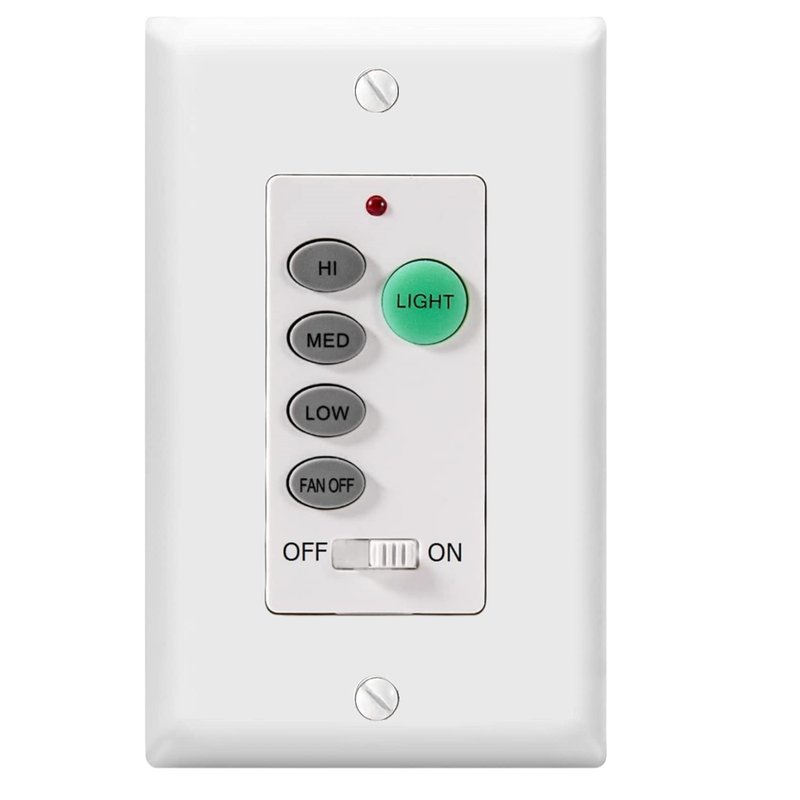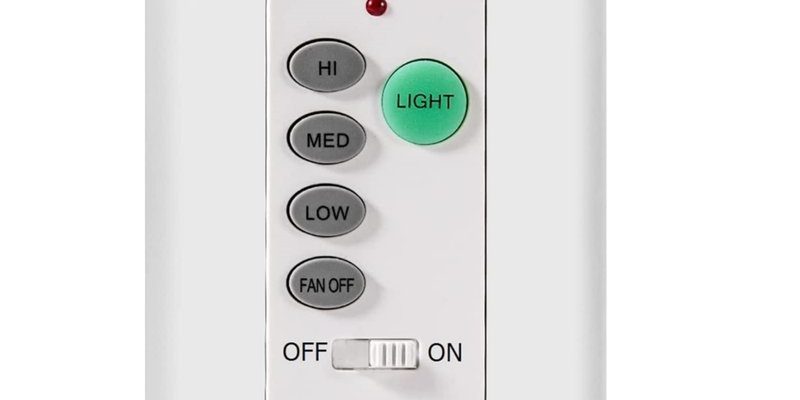
Let me explain it in everyday terms. Think of your Westinghouse fan as a band. The remote is the lead singer. The wall switch is the stage manager—it can turn off power for the whole show, but the singer handles the details, like which song to play (fan speed) or when to dim the lights. If you’ve never set up a ceiling fan remote before, or you keep hitting the wall switch and wonder why the remote suddenly stops working, don’t worry. You’re not alone. We’ll walk through it together, step by step, until it all makes sense and you’re in control.
How a Westinghouse Ceiling Fan Remote Works With Wall Switches
A lot of people expect their ceiling fan remotes to work no matter what. But here’s the catch: the remote can only send signals to the fan when it actually has power. That’s where the wall switch comes in. When you flip the wall switch off, you’re cutting electricity to the whole fan and its receiver—that little box tucked inside the fan canopy. When that receiver has no power, the remote can shout all it wants, but nothing happens.
So, for the remote to work, you need to leave the wall switch in the “on” position. Your wall switch kind of becomes the master power, while the remote is your fine-tuning tool for fan speed and light controls. If you turn the switch off, it’s like unplugging your TV. Nothing will respond until you restore its power.
For those who want both worlds—manual backup and the ease of a remote—it’s smart to train yourself (and your family) to leave the wall switch on. Use the remote for daily controls. The switch is only for true power cuts, like when you want to change a bulb or work on the fan safely.
Pairing and Syncing Your Westinghouse Remote With the Fan
You might be wondering, “How do I actually connect the remote to my Westinghouse ceiling fan?” It sounds technical, but it’s usually simpler than pairing Bluetooth headphones. Each remote communicates using a code, set by a series of tiny switches (DIP switches) or auto-sync tech, depending on the model.
Here’s what the basic pairing process looks like:
- Turn off power at the wall switch or breaker before you start. Safety first.
- Open the fan’s canopy to access the receiver if you need to set codes manually. Check your manual for the exact spot.
- Set the DIP switches on the remote and receiver to match. This keeps neighbor remotes from messing with your fan.
- Restore power. Hold down the “Learn” or sync button on the remote if your model has one.
- The fan should respond with a click or light blink. That means it’s paired.
If nothing happens, double-check the codes or try resetting the remote. Honestly, matching codes is the
Main Differences: Using Remote vs. Wall Switch for Control
A lot of folks ask, “Do I really need the remote if I have a wall switch, or vice versa?” Here’s where things get interesting. The wall switch gives you hardwired power control. It works every time, battery or no battery, and is usually close to your door. The remote, though, offers more control—think fan speeds, reverse function, and light dimming, all from your couch or bed.
Here’s how the two stack up:
- Wall Switch: Simple, failsafe, but only on/off control.
- Remote Control: Flexible settings, but relies on batteries and a working receiver.
I’d compare the remote to having a TV remote and your wall switch to the TV’s physical power button. One is for quick, easy changes; the other is for full shutdown or reset.
If you want both, the trick is to never turn off the wall switch unless you’re doing maintenance. Otherwise, you’ll be troubleshooting a “broken” remote that isn’t actually broken—it just lost power at the wall.
Solving Common Problems Using Westinghouse Remote With a Wall Switch
Sometimes you follow all the steps, but things still don’t work as expected. The fan ignores the remote, or the light flickers randomly, or you find yourself swapping batteries far too often. Troubleshooting isn’t glamorous, but it’s necessary.
Here are some real-world snags:
- Remote not working? Check if the wall switch is on. If it is, swap the batteries. Still nothing? Try re-pairing by holding the “Learn” button again.
- Fan or light keeps turning off? Someone may have flipped the wall switch off—or there’s a loose wire connection behind the switch plate.
- Remote controls the wrong fan? Code mismatch. Double-check that the DIP switches match between the remote and the receiver up in the fan.
If your fan acts possessed—randomly starting or stopping—it’s almost always the sync code picking up a neighbor’s signal. Reset the code, and you’ll reclaim control like a true tech wizard.
Having both a wall switch and a remote isn’t a bug; it’s a feature—if you get the setup right and everyone in the house understands their role. Leave a sticky note near the switch, if needed, until everyone gets the hang of it.
How To Reset or Re-Pair a Westinghouse Ceiling Fan Remote
Sometimes, the remote just needs a fresh start. Maybe the battery died and now the remote feels out of sync, or maybe you just moved into a new house and want to make sure no one else has control over your fan.
Here’s a step-by-step reset and pairing guide:
- Turn off the fan’s power using the wall switch or breaker.
- Wait 30 seconds for the receiver to power down completely.
- Turn the power back on.
- Within 30 seconds, hold down the “Learn” button on the remote (often found in the battery compartment) for 3–5 seconds.
- The fan and/or light should respond with a blink or beep, showing it’s paired.
If you’re still stuck, check if there’s a reset button on the receiver. Models vary, but this process covers most Westinghouse ceiling fan remote models.
Pro tip: Always keep spare batteries on hand, and check them first before you assume something bigger is wrong. 9 out of 10 “broken” remotes just need a fresh battery.
Comparing Universal Remotes vs. Westinghouse Brand Remotes
You might have wondered if a universal ceiling fan remote would work, especially if you lost your original Westinghouse remote. Here’s the deal: most universal fan remotes will work if you match the receiver and remote, but you’ll miss out on some brand-specific features.
Universal remotes handle basic stuff—on/off, light, and speed changes. Some can even pair with multiple brands, using a similar code system. But, advanced features like reverse mode or precise dimming sometimes only work with the original Westinghouse remote and receiver combo.
Choosing between a universal and the original comes down to this: if you lost the remote, grab a universal kit as a fix. But if you want all the features, try searching for a genuine Westinghouse replacement or contact the manufacturer for your specific model.
Troubleshooting Battery and Signal Problems
Batteries might seem simple, but honestly, they cause a surprising percentage of ceiling fan headaches. If your Westinghouse remote starts to lag, works only up close, or stops working entirely, swap the battery first. Most remotes use a standard A23 or coin cell. Never force the compartment open—these things are stubborn but delicate.
Signal issues are another beast. Thick walls, metal fixtures, or even Wi-Fi signals can mess with your remote’s reach. If you find the remote works in some corners of the room but not others, try pointing it directly at the fan, or move anything that could block the signal.
Pro tip: If you just changed the batteries but the remote’s still not working, try re-pairing the remote. Sometimes the receiver “forgets” its connection after losing power.
Safety Tips When Using Wall Switch and Remote Together
Working with electrical devices always means a little caution goes a long way. If you decide to open the fan canopy to check codes or reset things, flip off the breaker. Even a switched-off wall plate might let trickle current through, and it pays to be safe.
Another tip: never install a dimmer switch for your fan unless the fan and remote are both rated for dimming. Standard dimmers can fry the receiver or cause unpredictable behavior. Stick with a plain on/off wall switch for fans paired to remotes.
If you’re ever unsure, don’t hesitate to call a licensed electrician. No shame in asking for help, especially when safety and peace of mind are on the table.
Finishing Up: Getting the Best Out of Your Ceiling Fan Setup
Learning how to use a Westinghouse ceiling fan remote with a wall switch is a bit like learning a new dance. At first, you might step on a few toes—forgetting the wall switch, losing sync, chasing down tiny batteries—but after a while, the process becomes second nature.
Set the wall switch to “on” and leave it there, use the remote for smooth control, and remember the basics of pairing and resetting if something feels off. A little patience at the start saves a lot of frustration later. With these steps, you’ll have cool air, perfect lighting, and total control at your fingertips—every time you walk in the room.
